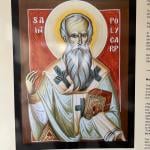The Biblical Cosmos: A Pilgrim’s Guide to the Weird and Wonderful World of the Bible.
Cambridge: Lutterworth Press, 2015.
Available at Amazon.com
Reviewed by Jill Firth
‘This book is smokin’ hot! I wish I’d read this while I was alive’ (St Augustine)
Roaaaaarrrr! (Leviathan, mythical chaos monster)
These imaginative ‘recommendations’ which introduce Parry’s introduction to the biblical cosmos give an orientation to his weird and wacky style, however, the book also carries endorsements from Hans Boersma (Regent College Vancouver) and Gordon Wenham (Trinity College Bristol) which intrigue us to read on further.
Parry presents a clear introduction to the Biblical cosmos based on insights from writings and images from the Ancient Near East which help us to enter more accurately into the biblical worldview. The book contains maps, diagrams and conceptual sketches that help us to imagine the world through the eyes of an ancient biblical person. Students may be familiar with ideas such as the geocentric three decker universe, but Parry’s depiction of this as a cylinder of increasing holiness gives us an increased grasp not just of the geography of the ancient worldview, but also of its theology.
There are four parts to the book. A Tour of the Biblical Earth shows us the land, sea and Sheol. A Tour of the Heavens takes us to the sky and to God’s heaven. Part III invites reflection on the relationship between the temple and the cosmos, with an interesting chapter on Jesus and the biblical cosmos. The final section invites us to consider how we as Christians can inhabit the biblical cosmos today. This would not be by beginning to believe in the structure of the ancient universe, such as a flat earth or the sky as a solid dome. While God accommodated his communication to the worldview of his ancient people, the main point was the message he was giving. Parry argues that though we should not believe in a flat earth, we can still learn from this way of looking at the world, for example, we can see the cosmos as a temple, where God can be known and worshipped. Parry is presenting a Pilgrim’s Guide – his goal is to help us to find and know God as he has revealed himself in Scripture.
There are a few quirky aspects to Parry’s style, such as calling YHWH Jehovah (because our Bibles usually translate YHWH as LORD, and Parry wants us to experience the way readers of the Hebrew text of the OT see the Tetragrammaton but say ‘Adonai’ because the vowels of Adonai are placed on the consonants YHWH). Also, Parry’s application of the work of John Pilch on alternate states of consciousness to Scriptural narratives is sometimes surprising.
Robin Parry is Theological Books editor for Wipf and Stock Publishers, and author of a number of books including Worshipping Trinity: Coming Back to the Heart of Worship, Old Testament Story and Christian Ethics, and the Two Horizons Commentary on Lamentations. He blogs at http://theologicalscribbles.blogspot.com.au/
The Biblical Cosmos: A Pilgrim’s Guide to the Weird and Wonderful World of the Bible is an enjoyable presentation which helps readers to enter into the biblical text. Those who know little about the world view of the ANE will become more informed, and all will be invited to engage more deeply with a way of looking at reality which is so different from our own.
Jill Firth lectures in Hebrew and Old Testament at Ridley College in Melbourne.












